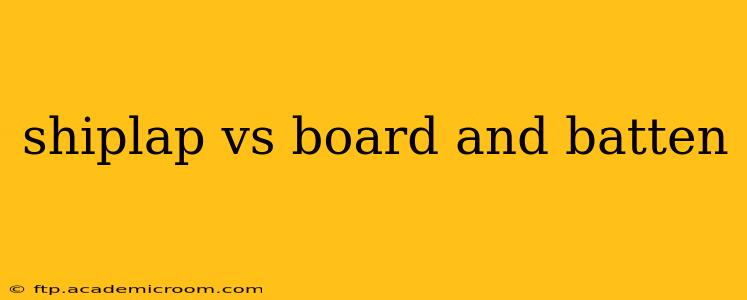Choosing the right siding for your home or interior project can be overwhelming. Two popular options often top the list: shiplap and board and batten. While both offer a rustic charm and visual appeal, they differ significantly in their construction, installation, and overall aesthetic. This comprehensive guide will delve into the key differences between shiplap and board and batten, helping you make an informed decision for your next project.
What is Shiplap?
Shiplap is characterized by its overlapping boards, creating a seamless, weather-resistant surface. The edges of each board are beveled, allowing for a snug fit and preventing gaps. This overlapping design is what gives shiplap its distinctive look and provides superior protection against the elements, making it a popular choice for exterior applications. Historically, shiplap was used in shipbuilding due to its strength and water resistance. Today, it's a beloved choice for both interior and exterior walls, ceilings, and even accent features.
What are the advantages of shiplap?
- Weather Resistance: The overlapping design creates a watertight seal, making it ideal for exteriors.
- Clean Lines: The simple, overlapping design offers a clean and modern aesthetic.
- Versatile: Works well in various styles, from rustic farmhouse to contemporary modern.
- Durability: Typically made from durable materials like wood, it can last for many years.
What are the disadvantages of shiplap?
- Cost: Can be more expensive than board and batten, especially if using higher-quality wood.
- Installation: Requires precise cutting and fitting for a clean look.
- Maintenance: Wooden shiplap requires regular maintenance like painting or staining to prevent weathering.
What is Board and Batten?
Board and batten siding features wide vertical boards separated by narrow vertical strips, called battens. These battens cover the gaps between the boards, creating a more structured and defined appearance than shiplap's continuous overlap. While it can also offer weather protection, the primary function of board and batten is aesthetic, adding a distinct vertical emphasis to a surface. This style is often seen on barns and traditional homes, lending a classic, rustic feel.
What are the advantages of board and batten?
- Cost-effective: Generally less expensive than shiplap, particularly when using less expensive wood types.
- Easier Installation: The design simplifies the installation process, making it DIY-friendly.
- Rustic Charm: Its distinctive design adds a classic, rustic aesthetic to any space.
- Variety of Materials: Available in a wide range of materials, including wood, vinyl, and composite.
What are the disadvantages of board and batten?
- Less Weather Resistance: Gaps between boards can allow moisture penetration, especially without proper sealing.
- More Maintenance (Wood): Wooden board and batten requires regular maintenance to prevent weathering and rot, particularly around the battens.
- Less Versatility: Primarily used for a rustic or traditional look, may not suit all interior design styles.
Shiplap vs. Board and Batten: Which is Right for You?
The best choice depends entirely on your project's needs and aesthetic goals. Consider these factors:
- Budget: Board and batten is usually the more budget-friendly option.
- Aesthetic: Shiplap provides a cleaner, more modern look, while board and batten offers a rustic, traditional charm.
- Location: Shiplap's weather resistance makes it a better choice for exterior applications, while board and batten can be used both indoors and outdoors with proper sealing.
- DIY Skill: Board and batten is generally easier to install than shiplap.
What is the difference between shiplap and tongue and groove?
While both shiplap and tongue and groove are types of wood paneling, they differ in their joining methods. Shiplap has overlapping boards with beveled edges, while tongue and groove features interlocking edges where one board's tongue fits into the groove of the adjacent board. Tongue and groove creates a tighter, more seamless joint, but is not as visually distinct as shiplap.
Is shiplap more expensive than board and batten?
Yes, generally shiplap is more expensive than board and batten. This is due to the more intricate installation process and the higher-quality materials often used for shiplap.
Can I use shiplap and board and batten together?
Absolutely! Combining shiplap and board and batten can create a visually stunning and unique design. For instance, you could use shiplap for a feature wall and board and batten for the remaining walls.
By carefully weighing these factors, you can choose the siding that best suits your style, budget, and project requirements. Remember to consider the material, installation method, and long-term maintenance when making your final decision.
